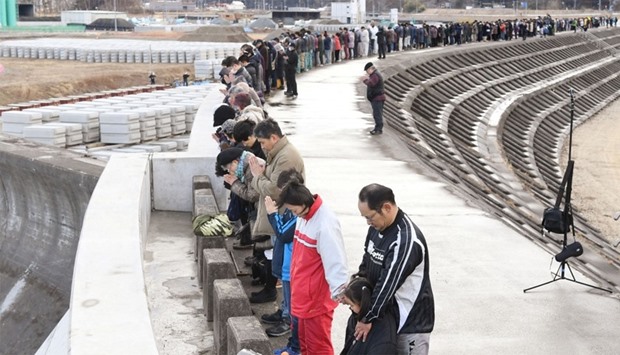The magnitude 9.0 quake, which struck under the Pacific Ocean on March 11, 2011, and the tsunami it spawned left about 18,500 people dead or missing.
The massive flow of water overwhelmed cooling systems at the Fukushima Daiichi power plant, causing meltdowns in three of its six reactors in what was the worst nuclear disaster since Chernobyl in 1986.
The quake and tsunami caused widespread damage to homes while radiation spread over a wide area, with more than 450,000 people evacuating in the immediate aftermath.
More than 123,000 remain displaced, the majority from Fukushima due to high radiation.
Prime Minister Shinzo Abe and other participants at a national ceremony in Tokyo bowed their heads in silent prayer, as did many residents across the affected region, at 2:46 pm (0546 GMT) -- the exact moment the quake struck.
The disaster ‘brought unprecedented damage’ and ‘claimed many precious lives’, Abe, dressed in formal mourning attire, told the solemn gathering.
‘I possess unceasing sympathy for those who lost beloved family members and friends.’
Japan's ageing Emperor Akihito and Empress Michiko did not attend this year's ceremony, but were represented by their son Prince Akishino and his wife Princess Kiko.
‘Many people are still forced to face difficult times in the disaster areas and evacuation places,’ Akishino said.
- Evacuation orders -
‘Especially for those in prolonged evacuations, I feel pain deep in my heart thinking about the health of those ageing year by year in the disaster zone and people who remain unable to return home due to high radiation levels.’
Separately, hundreds of police and firefighters combed beaches along the coast of Fukushima prefecture, as they do on the 11th of each month, in a search for remains or other evidence of people who remain unaccounted for.
The latest National Police Agency figures show that the total of dead or missing from the earthquake and tsunami stood at 18,446 people.
Besides the number of people killed in the quake and tsunami, more than 3,500 deaths from causes such as illness and suicide have been linked to the aftermath of the tragedy, according to government figures.
While no deaths have been attributed to radiation exposure, evacuees are concerned the government is moving too fast to deem once closed off areas safe to inhabit.
‘Many voluntary evacuees (from Fukushima) are mothers with small children fleeing from home in fear of radiation and the elderly who sought refuge in the homes of relatives,’ evacuee Miyako Kumamoto said at a press conference ahead of the anniversary.
‘We fled solely to protect our children and grandchildren from radiation,’ she said, criticising authorities for failing to help them.
‘I cannot accept this or understand why we have to be in this predicament.’
Government evacuation orders from some 70 percent of the originally closed off areas will be lifted by April 1, except for certain towns near the battered plant, and authorities are encouraging evacuees to return.
But many have criticised the government for moving too fast, saying radiation levels remain unsafe.
Tokyo Electric Power Co (TEPCO), the operator of the stricken plant, and the government are facing what is expected to be a four-decade task of cleaning up and decommissioning the facility.



